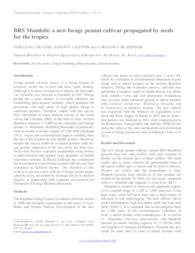BRS Mandobi: a new forage peanut cultivar propagated by seeds for the tropics .
BRS Mandobi: a new forage peanut cultivar propagated by seeds for the tropics .
Autoria: ASSIS, G. M. L. de; VALENTIM, J. F.; ANDRADE, C. M. S. de
Resumo: Forage peanut (Arachis pintoi) is a forage legume of relatively recent use in beef and dairy cattle feeding. Although it is native exclusively to Brazil, the first culti-var, Amarillo, was released in Australia in 1987. Forage peanut has a great number of favorable attributes for establishing grass-legume mixtures, which guarantee the persistence and high yields of high quality forage in cultivated pastures. Therefore, studies with this species have intensified in many tropical regions of the world (Assis and Valentim 2009). In the state of Acre, western Brazilian Amazon, 137,000 ha are cultivated with forage peanut, cv. Belmonte, benefiting thousands of producers, with an annual economic impact of USD 46M (Embrapa 2012). Social and environmental impacts resulting from the use of this legume are also highly positive. However, despite the success achieved in mixed pastures with for-age peanut, expansion of the area sown has been rela-tively slow because vegetative propagation using stolons is labor-intensive and requires large quantities of limited vegetative material. In Brazil, Embrapa has coordinated the development of new forage peanut cultivars and their evaluation in different biomes. The objective of this work is to present a new cultivar of forage peanut propa-gated by seeds, developed by Embrapa for use in tropical regions, in partnership with Unipasto (Association for Promotion of Forage Breeding Research).
Ano de publicação: 2013
Tipo de publicação: Artigo de periódico
Unidade: Embrapa Acre
Palavras-chave: Acre, Amazonia Occidental, Amazônia Ocidental, Animal nutrition, Arachis pintoi, Arachis pintoi cv Mandobi, BRS Mandobi, Cacahuetes forrajeros, Forage legumes, Forage peanut, Leguminosa forrageira, Leguminosas forrajeras, New variety, Nueva variedad, Nutrición animal, Nutrição animal, Variedade, Western Amazon
Observações
1 - Por padrão são exibidas publicações dos últimos 20 anos. Para encontrar publicações mais antigas, configure o filtro ano de publicação, colocando o ano a partir do qual você deseja encontrar publicações. O filtro está na coluna da esquerda na busca acima.
2 - Para ler algumas publicações da Embrapa (apenas as que estão em formato ePub), é necessário ter, no celular ou computador, um desses softwares gratuitos. Sistemas Android: Google Play Livros; IOS: iBooks; Windows e Linux: software Calibre.
Acesse outras publicações
Acesse a Base de Dados da Pesquisa Agropecuária (BDPA) para consultar o acervo completo das bibliotecas da Embrapa.

